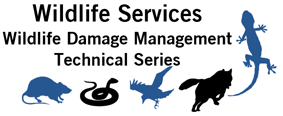U.S. Department of Agriculture: Animal and Plant Health Inspection Service
Date of this Version
8-2016
Document Type
Article
Citation
Wildlife Damage Management Technical Series, U.S. Department of Agriculture, Animal & Plant Health Inspection Service, Wildlife Services, August 2016
Abstract
Conflicts between humans and birds likely have existed since agricultural practices began. Paintings from ancient Greek, Egyptian, and Roman civilizations depict birds attacking crops. In Great Britain, recording of efforts at reducing bird damage began in the 1400s, with books on bird control written in the 1600s. Even so, the problem persists. Avian damage to crops remains an issue today, but we also are concerned with damage to homes, businesses, and aircraft, and the possibility of disease transmission from birds to humans or livestock. Successful dispersal techniques should capitalize on bird sensory capabilities. If birds cannot perceive the dispersal technique, it will not be effective in dispersing birds.
Not only must birds be able to perceive a dispersal technique, they also must interpret the technique as a threat to their safety. A technique that worked initially may fail later as birds habituate to it and no longer perceive the technique as threatening. For some species, the introduction of limited lethal control reinforces non-lethal dispersal techniques, as the birds again perceive the non-lethal technique as potentially dangerous. For other species, changing techniques is necessary, because they may not react to the death of a flock member and therefore still not interpret the scare technique as a threat. In either case, changing techniques and using multiple techniques in an integrated manner are essential for deterring birds from sensitive areas. No single technique or tool will deter birds in every instance or situation; there is no silver bullet. Successful bird dispersal involves a combination of tools and timing of use, as well as the skill and persistence of biologists and wildlife control operators (WCOs). The following sections offer overviews of various techniques that have been used to mitigate bird problems in various situations, as well as examples that highlight successful bird dispersal programs.
Included in
Behavior and Ethology Commons, Biodiversity Commons, Other Animal Sciences Commons, Other Ecology and Evolutionary Biology Commons, Population Biology Commons, Terrestrial and Aquatic Ecology Commons


Comments
Updated March 2019.